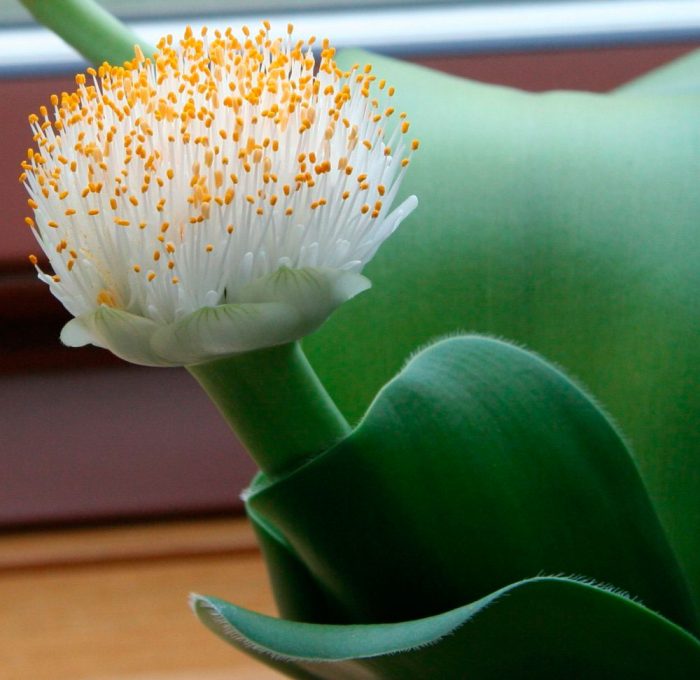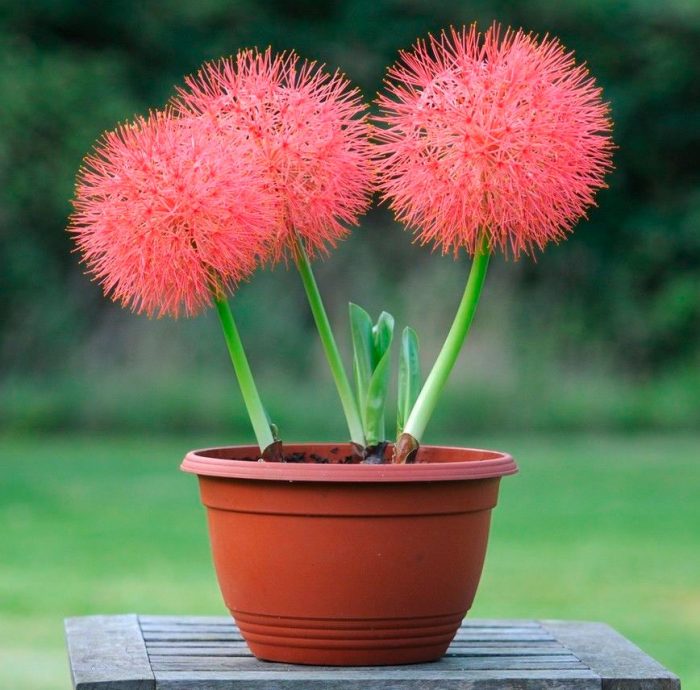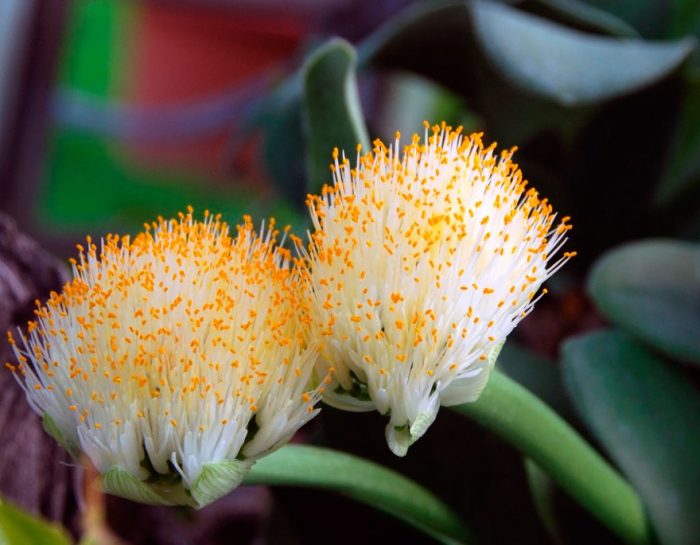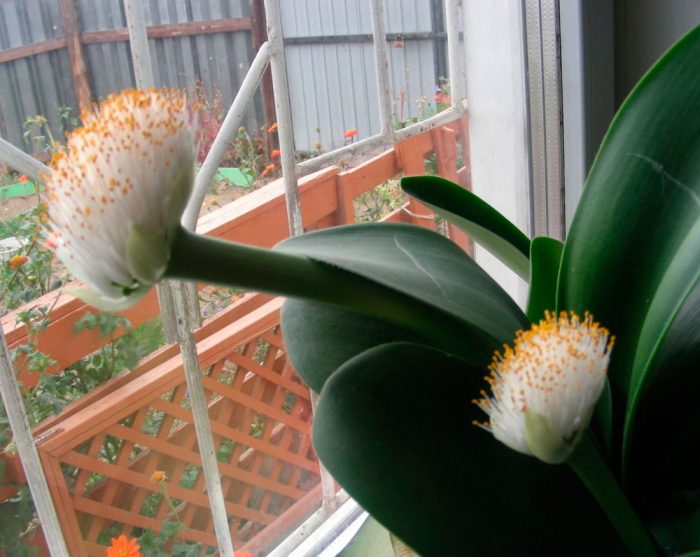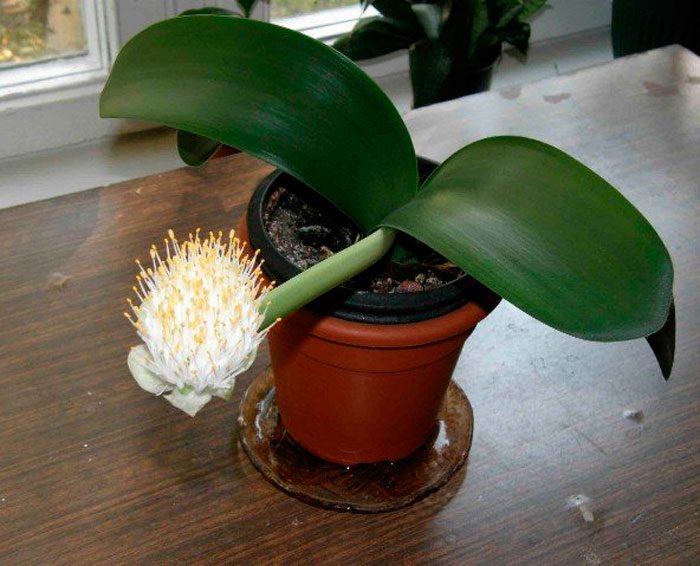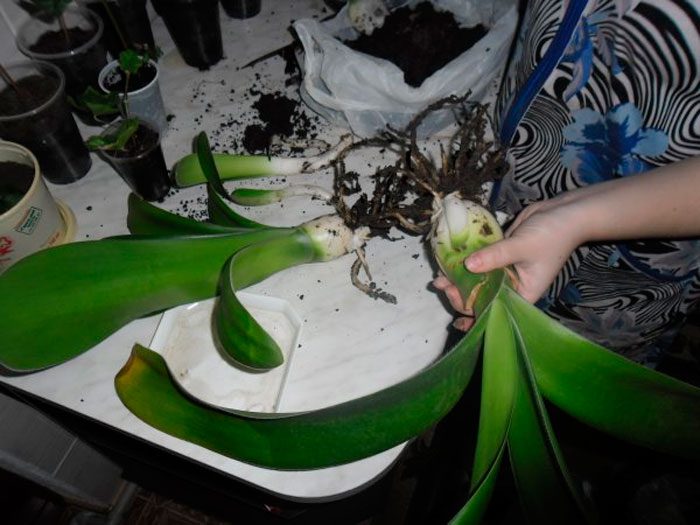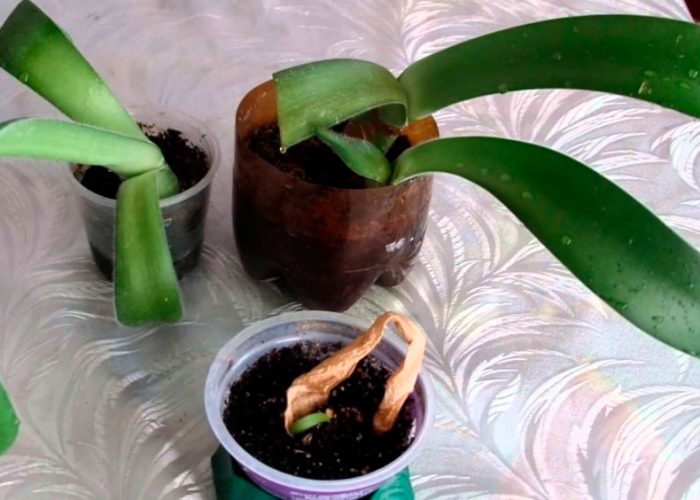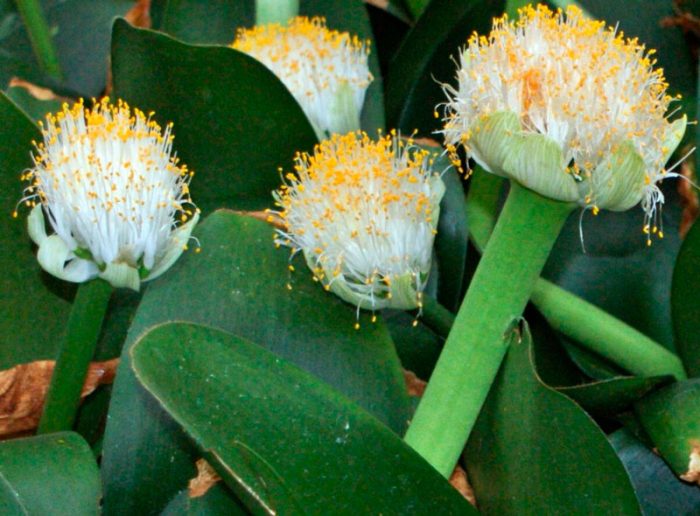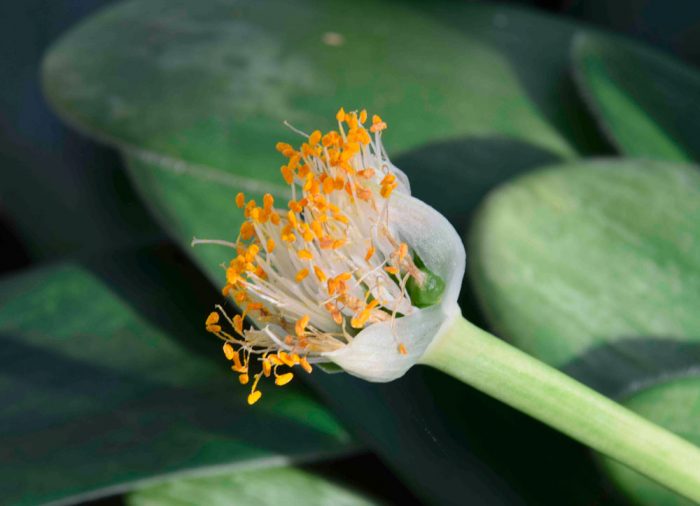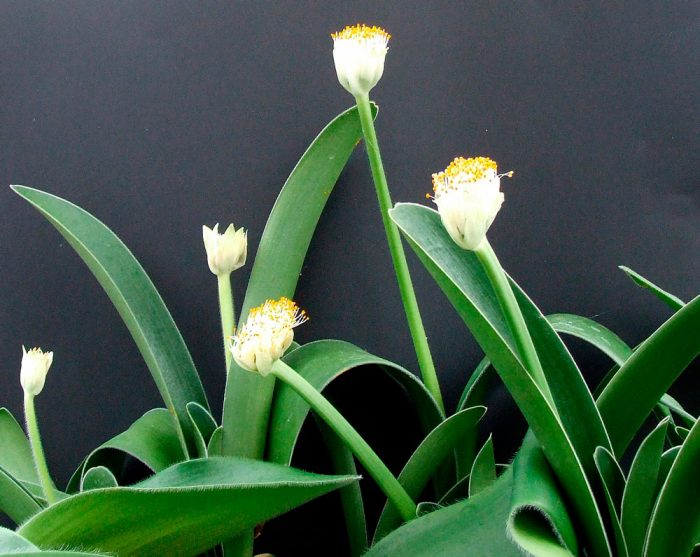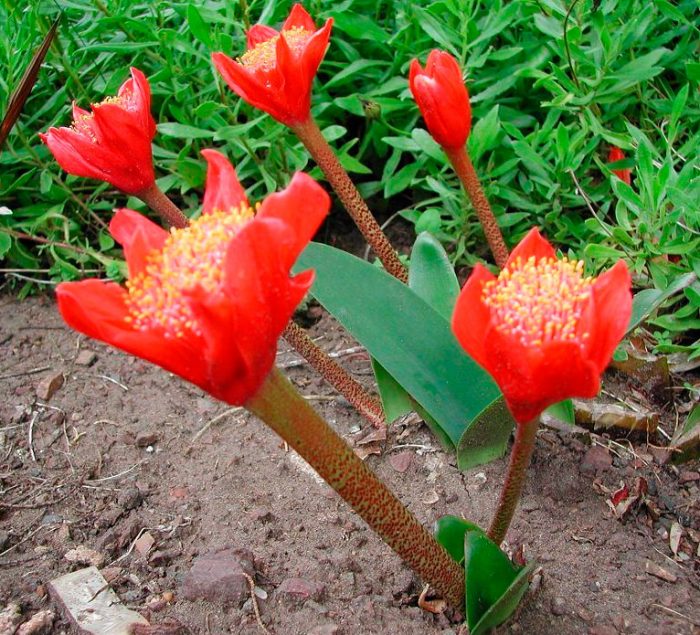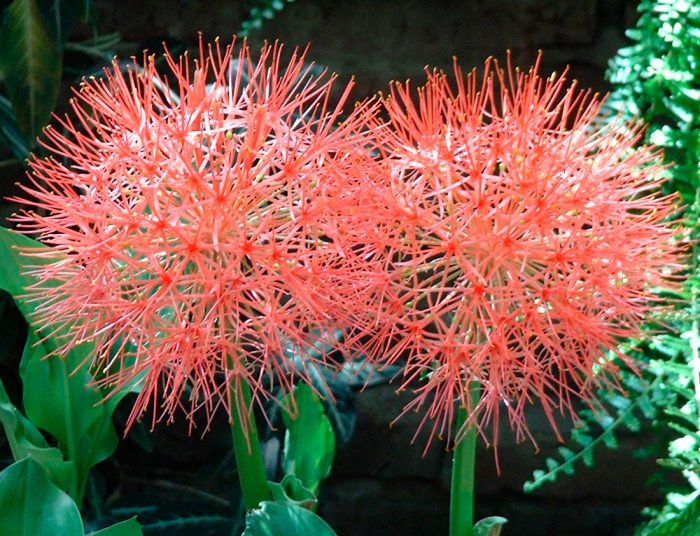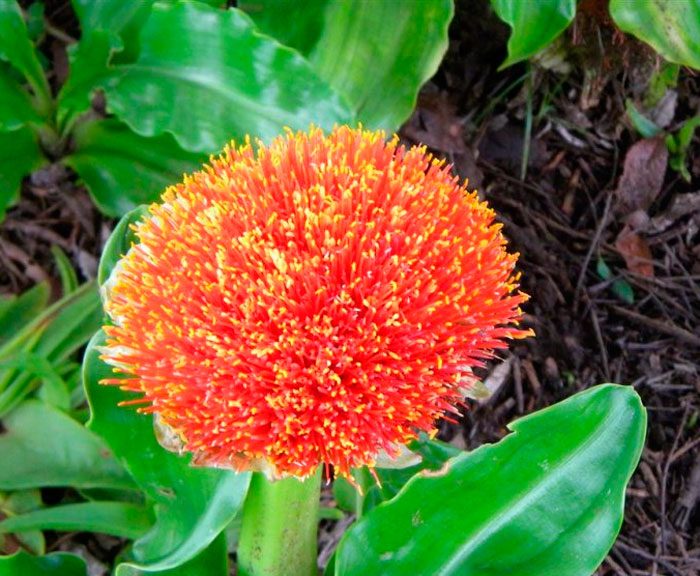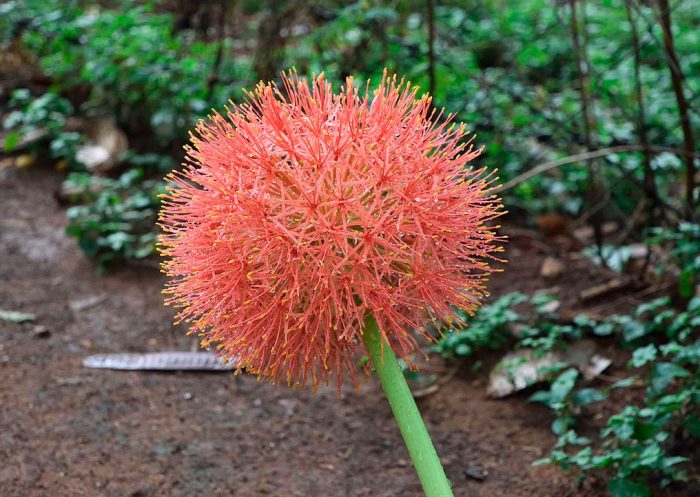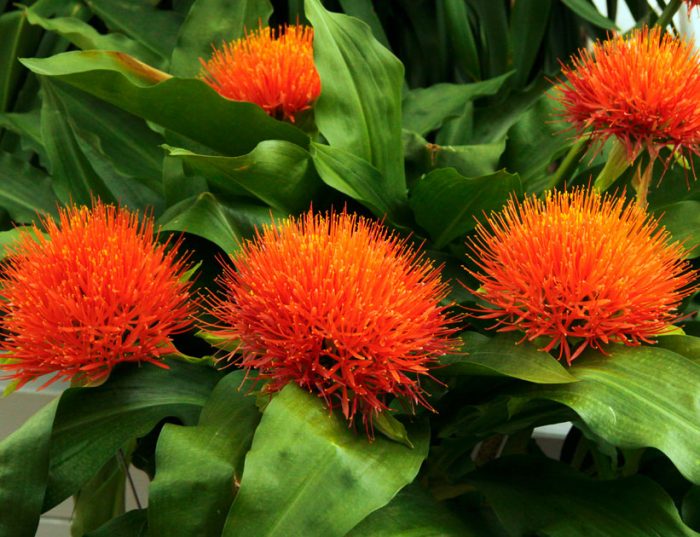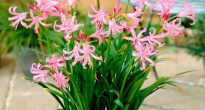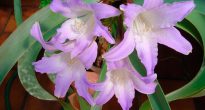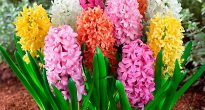The monocotyledonous plant Hemantus (Haemanthus) is a member of the Amaryllis family. Under natural conditions, it can be found in South America. This genus unites more than 40 different species. The genus was named "Hemantus" by Pitton de Tournefort, this is due to the fact that in the type species the flowers have a rich red color, from the Greek the word "hemantus" is translated as "bloody flower". The plant was described by Karl Linnaeus in 1753, while the name he left the same. Among flower growers, the most popular type is white-flowered hemantus (Haemanthus albiflos), popularly also called "deer tongue" or "elephant ear".
Content
- 1 Brief description of cultivation
- 2 Features of hemantus
- 3 Hemantus care at home
- 4 Reproduction methods
- 5 Diseases and pests
- 6 Types and varieties of hemantus with photos and names
- 6.1 White-flowered Gemantus (Haemanthus albiflos)
- 6.2 Scarlet Hemantus (Haemanthus coccineus)
- 6.3 Hemantus Linden (Haemanthus lindenii)
- 6.4 Hemantus snow-white (Haemanthus candidus)
- 6.5 Tiger Gemantus (Haemanthus tigrinus)
- 6.6 Hemantus pomegranate (Haemanthus puniceus)
- 6.7 Hemantus multiflorus (Haemanthus multiflorus)
- 6.8 Gemantus Katherinae (Haemanthus Katherinae)
Brief description of cultivation
- Bloom... July to August.
- Illumination... Can be grown in a slightly shaded area or in bright, diffused light.
- Temperature regime... 18 to 22 degrees.
- Watering... During the growing season, the substrate in the pot is moistened immediately after its top layer dries. It is not necessary to water the flower during the dormant period.
- Air humidity... It grows well at any level of humidity.
- Fertilizer... During the growing season, feeding is carried out 1 time in 15–20 days, for this they use a mineral complex fertilizer for bulbous plants. During the dormant period, the hemantus does not need feeding.
- Transfer... The bush is rarely transplanted, namely, once every 4 or 5 years, they do it in the last days of February or the first days of March.
- Reproduction... Daughter bulbs, leaf cuttings and seed method.
- Diseases... Root rot and staganosporosis.
- Harmful insects... Scabbards and spider mites.
- Properties... Hemantus bulbs contain poison.
Features of hemantus
Unlike other representatives of the Amaryllis family, the white-flowered hemantus is an evergreen plant. It grows all year round and does not lose its decorative effect even in winter. And in other species of hemantus, a dormant period is observed in the winter.The shape of the bulbs can be ovoid or pear-shaped, in some cases they are flattened from the sides. The bulbs are about 12 centimeters across. On the bush grows a small number of fleshy belt-like leaf plates with a green color and rounded ends. The height and vigorous flower stalks and foliage can reach about 20 centimeters. Up to three pairs of leaf blades can form on each of the bulbs, while only one pair is formed during one season. The foliage surface can be smooth, sticky to the touch, or covered with pubescence. It is placed in pairs and hangs down symmetrically. What many growers take for a hemantus flower is in fact not a flower, but a spherical bunch consisting of yellow stamens collected in an umbrella-shaped inflorescence. They are surrounded by juicy bracts, of which there are 4 pieces, while they are painted in the same color shade as the stamens, namely, orange, red or white. The color of stipules and stamens depends on the type and variety of the plant. The beginning of flowering occurs in the middle of the summer period, at this time the plant is decorated with flowers that look similar to openwork pompoms. The plant fades in late autumn. After the hemantus begins to secrete pollen and nectar, it develops a characteristic unpleasant aroma. Self-pollinated flowers form an ovary, which is represented by red-white round berries, reaching 10–20 mm in diameter. They quickly lose their germination.
Hemantus care at home
Gemantus is distinguished by its unpretentiousness and undemanding care, which greatly facilitates its cultivation at home. Those growers who have already grown it claim that it needs the same care as succulent plants.
Temperature regime
The flower grows and develops normally at an air temperature of 18 to 22 degrees. It does not have a dormant period; therefore, it is not necessary to rearrange the plant to a cooler place in winter. However, deciduous varieties and species are best kept in a room with an air temperature of 10 to 12 degrees during the winter months. In the summer, it is recommended to take the bush to fresh air, while choosing a place for it that has reliable protection against drafts.
Illumination
This plant can be grown in light shade or well-lit area and will grow equally well. Window sills of east, west and north-east orientation are best suited for it. A southern window is also suitable for growing it, but in this case, at noon, it will need shading from the scorching rays of the sun.
Watering
The substrate in the pot is moistened immediately after its surface dries. Make sure that no liquid stagnation is observed in the root system of the bush, as this can cause rot on the bulb. In late autumn, a gradual reduction in watering is carried out, while during the dormant period, which lasts 4-8 weeks, the bush is not watered at all. For irrigation, use thawed, well-settled or filtered water, the temperature of which should be close to room temperature.
Air humidity
The plant does not need high air humidity, therefore, it is not necessary to systematically humidify it from a spray bottle. And in order to clean the leaf plates from dust, they must sometimes be wiped with a damp sponge.
Top dressing
Organic fertilizers cannot be used to feed the hemantus, as it reacts to them very badly. Mineral complex fertilizers with a high content of phosphorus and potassium are best suited for this. You can also use fertilizer for bulbous plants for feeding. Fertilize the flower from the beginning of the growing season until it blooms, once every 15–20 days.During the dormant period, the plant does not need feeding.
Hemantus transplant
An adult plant is rarely transplanted, or rather, once every 4 or 5 years. During this procedure, children are separated from the parent bulb. It is recommended to transplant in the last days of February or the first - in March, since this time falls at the beginning of the growing season, and therefore the bush takes root very quickly.
For hemantus, you should choose a low and wide pot, which is filled with a substrate consisting of sod, leafy and humus soil, as well as sand, which are taken in equal proportions. Do not forget to make a good drainage layer at the bottom of the container, this will help protect the plant from stagnation of liquid in the soil mixture. The flower does not like to sit too deeply, therefore, during transplantation, its bulb is buried in the soil mixture by only 1/3 part. If you plant several bulbs at once in one container, then as a result you will get a lush and very effective bush.
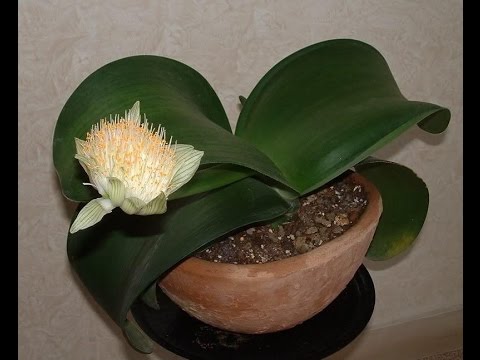

Watch this video on YouTube
Reproduction methods
Reproduction by children
For the reproduction of hemantus, children are used, the seed method and leaf cuttings. The easiest of these methods is to reproduce by children. During transplantation of the bush, they are separated from the mother bulb and planted as independent flowers in separate pots. Please note that only those children who have their own foliage and roots are separated and planted. Children take root quite quickly, and the first flowering of a young bush can be seen 3 or 4 years after planting.
Propagation by leaf cuttings
Growing a new bush from a leaf cut is much more difficult than growing from a baby, but it is quite possible. A lower leaf plate with a fleshy base is cut off from an adult bush. Sprinkle the cut with crushed charcoal and leave the cutting outside for 24 hours to dry well. For rooting, the cutting should be planted in a mixture of sand and peat, then it is placed in a warm place and systematically watered moderately. The rooted stalk is transplanted into a pot filled with an adult Hemantus soil mixture (see above). A bush that has grown from a cutting will bloom for the first time after 3 or 4 years.
Growing from seeds
Seeds of hemantus grown indoors are very rarely propagated, since they retain good germination for a very short time. If you were able to collect the seed material in time, then evenly distribute it over the surface of the moistened soil mixture (you do not need to sprinkle it with earth on top), cover the container with glass on top. If you are lucky, and you see seedlings, then for the first time they will bloom only after 5 or 6 years.


Watch this video on YouTube
Diseases and pests
Diseases
Gemantus is highly resistant to disease. However, if you take care of him incorrectly, then he can get sick. For example, the defeat of the plant by fungal diseases and the appearance of rot on the bulbs may be due to the fact that it is watered very often or excessively.
In rare cases, the flower can infect staganosporosis (red rot, or red burn), mainly hippeastrum and amaryllis are susceptible to this disease. Symptoms are orange-red streaks and specks on the leaf blades. Cut off all affected parts of the bush and spray it with a special agent, for example: copper oxychloride, Bordeaux liquid, copper sulphate, or another preparation containing copper used to fight fungal diseases. Move the bush to a place that is well lit, but protected from direct sunlight, and as for watering, you need to moisten the substrate in the pot in such a way that no liquid stagnation occurs in it.
In some cases, flower growers wonder why their outwardly healthy hemantus does not want to bloom? Flowering may be absent if during the growing season the plant did not receive enough water or optimal conditions were not provided for it during the dormant period, especially if a deciduous species of hemantus is grown. At the time of rest, the bush is rearranged in a cool and well-lit place and is practically not watered at all.
Harmful insects
Most often, scale insects or spider mites settle on the hemantus, most often this occurs in the summer on hot days. If scale insects have settled on a flower, then, as a rule, they hide in the leaf sinuses and on the seamy surface of the foliage. Moisten a cotton pad in alcohol or soapy water and remove the pests from the flower, then rinse it thoroughly under a warm shower and wait for it to dry completely. Then carry out the treatment with Karbofos or another means of a similar action.
If spider mites have settled on the bush, then they can be detected by small faded dots on the foliage (places of bite) and by a thin cobweb. If there are a lot of pests, then dark spots are formed on the leaf plates, gradually turning yellow and drying out. To kill ticks, acaricidal agents are used, for example: Aktara, Fitoverm or Aktellik.
Types and varieties of hemantus with photos and names
Of all the types of hemantus, the most popular among flower growers are such as: scarlet and white-flowered. However, scadoxus are also often called hemantus, these plants are very similar to each other and are related. Since scadoxus are also part of the Amaryllidaceae family and are grown indoors in almost the same way as hemantus, a description of some species of this plant will be given below.
White-flowered Gemantus (Haemanthus albiflos)
This evergreen plant is highly decorative. Its smooth, thick, wide, tongue-shaped leaf plates are painted in a dark green color, they reach up to 10 centimeters wide, and about 20 centimeters long, with cilia along the edge. Powerful peduncles are about 25 centimeters high. At the tops of the flower arrows, globular umbellate inflorescences of white color are formed, which adorn the tips-anthers of a golden hue.
Of all the varieties of this species, the most popular is Prince Albert: compared to the base species, this variety has larger inflorescences, and they have a bright orange color.
Scarlet Hemantus (Haemanthus coccineus)
Leaf plates with red tops reach a height of about 50 cm. Peduncles of the species are spotty, spectacular red inflorescences adorn yellow anthers. Perianth petals are rather large. When grown in indoor conditions, the flowering of such a plant is not observed annually, but inflorescences are formed in the autumn and wither relatively quickly.
Hemantus Linden (Haemanthus lindenii)
In the bush, long-petiolate leaf plates are arranged in 2 rows, along the median vein they have longitudinally located folds. The height of the peduncles is about half a meter, and the inflorescences reach about 20 centimeters in diameter. They include umbrellas of deep red color, up to 50 mm in diameter.
Hemantus snow-white (Haemanthus candidus)
This variety is similar to the white-flowered hemantus, however, it has pubescence on the peduncles and the seamy surface of the leaf plates.
Tiger Gemantus (Haemanthus tigrinus)
This plant was created by selection. The length of the leaf plates is about 0.45 m; there are brown specks on their surface. The height of the peduncles is only about 15 centimeters, large red inflorescences form on their tops.
Hemantus pomegranate (Haemanthus puniceus)
Or pomegranate scadoxus (Scadoxus puniceus). The foliage of such a plant is leathery with a wavy edge. Red inflorescences reach up to 10 centimeters across.
Hemantus multiflorus (Haemanthus multiflorus)
Or Scadoxus multiflorus. The leaf plates of this species are veiny. On long peduncles, large inflorescences of scarlet red or pale pink are formed.
Gemantus Katherinae (Haemanthus Katherinae)
Or Scadoxus Katherinae. This variety is very popular with flower growers. The height of the false stem is about 15 centimeters; thin and long leaf plates sit on it. In the last summer weeks, red inflorescences are formed on the flower.
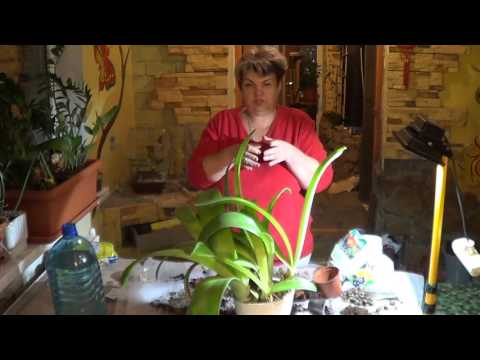

Watch this video on YouTube

